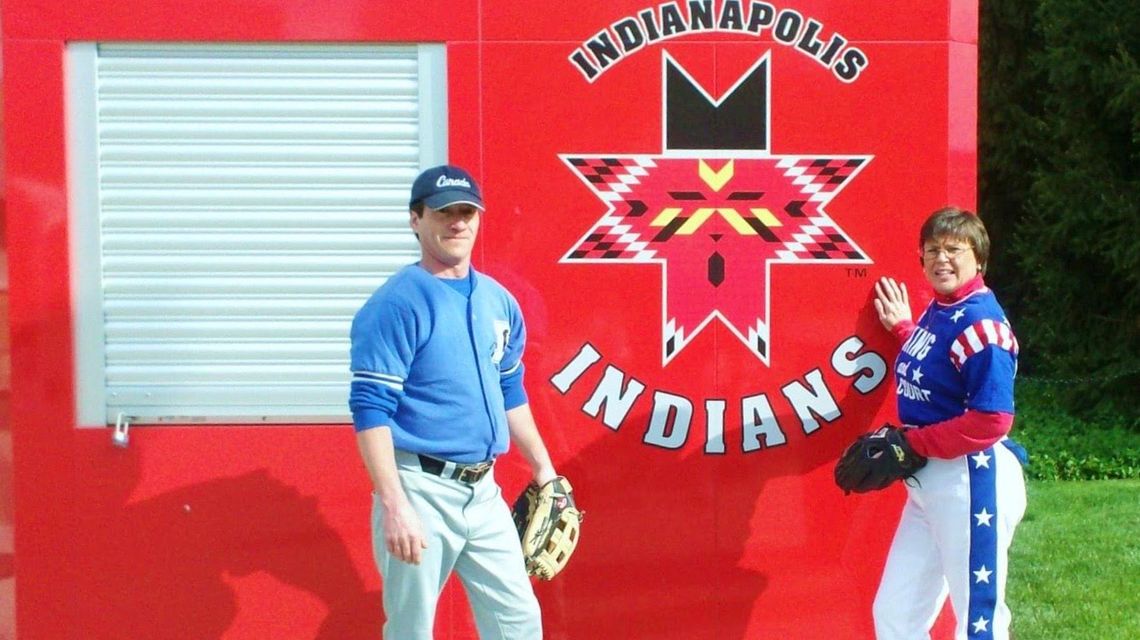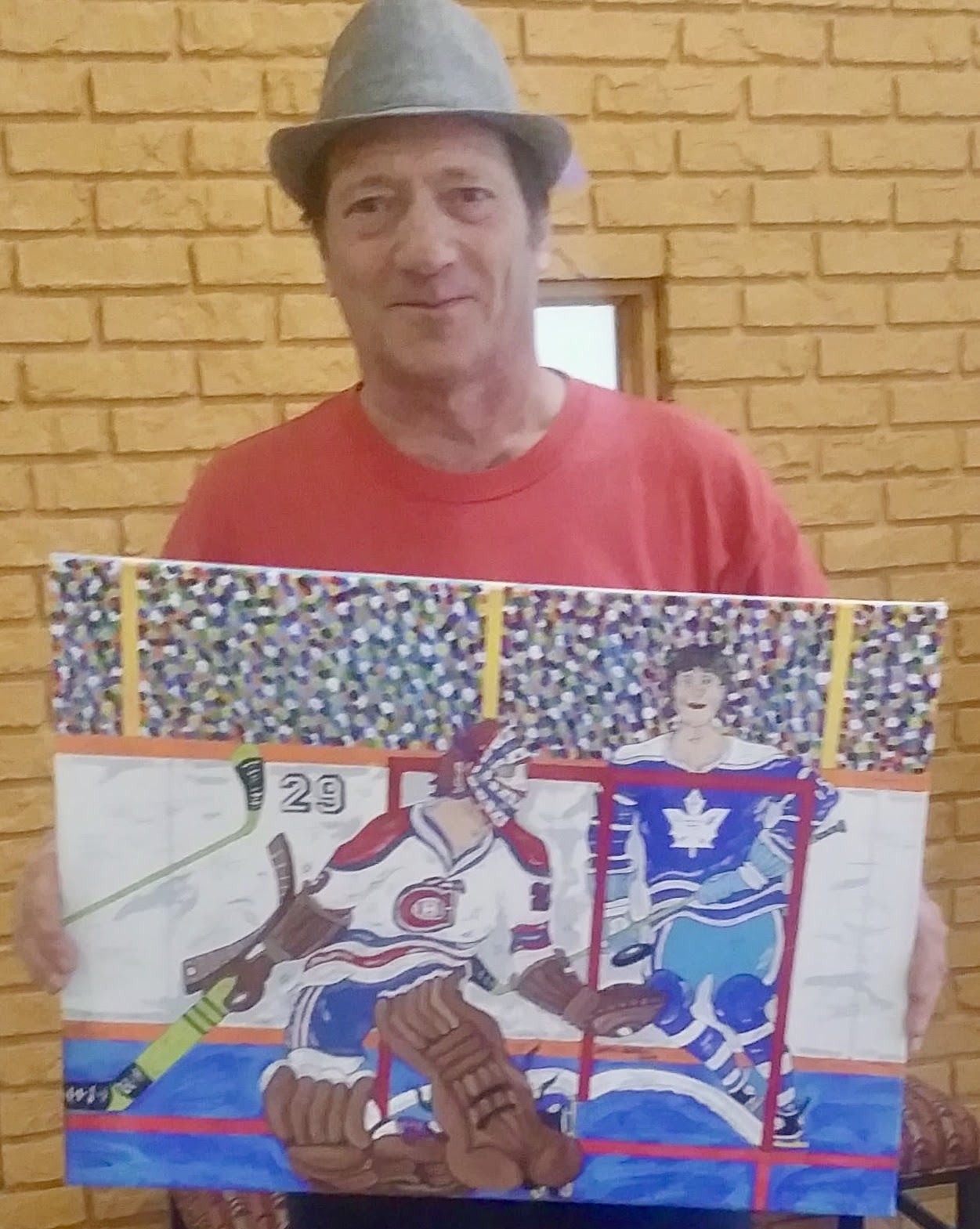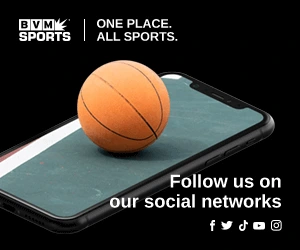
Trading bat for brush
FORT ERIE, Ontario (BVM) – Legacy is about learning from the past, living in the present, and building for the future. A lifelong baseball enthusiast, Dave Eberly knew when the time came for him to trade in his baseball cap and bat for a paintbrush and canvas.
Growing up in Stevensville, Ont., Eberly fondly recalls playing little league baseball and at age 11 the excitement of making it to Triple-A.
Eberly was only 13 when he caught the attention of a world-famous fast-pitch travel team and was invited to join up. Being too young and also having his eye on becoming a big league hardball player, Eberly turned down the offer. He instead spent his teens attending practices with the Buffalo Bisons. But as fate would have it the historic team (today the Triple-A affiliate of the Toronto Blue Jays), was on hiatus those years, said Eberly, and no actual games were being played.
By the time he moved to the Toronto area at 18, Eberly had all but left behind his childhood dreams of playing in the big leagues. He didn’t quit baseball completely. When he wasn’t at work, Eberly stayed active coaching local kids and also played recreationally in a city-wide men’s league for a decade.
Even after years of no physical involvement in the sport, Eberly couldn’t shake his love for the game. Looking back, he can piece together his journey with pro softball that never happened.
He was 14 when he met Gordie Howe while he was on tour in Toronto. That day, Eberly was more than thrilled to meet “Mr. Hockey,” who asked him if he played too. Eberly politely told the NHL great that no, baseball was his game. Howe started to tell Eberly about a good friend of his who played travel softball.
“He said he could easily put me in touch with the team,” Eberly said, adding that he smiled at Howe and thanked him for the offer, but he wasn’t interested in a softball career.
When it came to softball, it was starting to feel like the boomerang effect was in play for Eberly.
Years later, in 2005, he was browsing the internet and came across a book, From Orphan To A King, that finally revealed who Howe was referring to. Eberly smiled to himself when he saw Howe credited as the writer of the book’s forward.
He was immediately hurled back in time to a summer day in the mid-1970s. Eberly’s father took him to the local ball diamond to watch his hometown hardball team take on a four-man softball exhibition team.
It turns out that Eberly had already been offered a position by Howe’s softball friend. Eberly quickly put two and two together and realized it was Eddie Feigner of The King and His Court. When Feigner spent the week in town to play the Stevensville team, Eberly noticed him while sitting in the bleachers at a few of his games.
Feigner had noticed Eberly too.
He and one of his teammates were chosen to attend a meet-and-greet with Feigner after his game against Stevensville.
The King and His Court had played in small towns across North America against local teams for 59 years. Feigner and a changing supporting cast (which included only a catcher, first baseman and shortstop) logged more than 6 million kilometers covering more than 100 countries to play in front of 200 million people.
Thirteen-year-old Eberly was a little bored and not overly excited to meet the King of Softball that day, but he vividly remembers Feigner’s words to him.
“Eddie said he could see me playing pro someday, so I asked him if he thought I might play for the Expos. He kind of chuckled and said, ‘No, but you could play for my team anytime,’” Eberly laughed retelling his recollection of the conversation.
Thirty years later, while ordering the book from The King and His Court website, Eberly noticed an invite to fans to share their stories of meeting Feigner.
It’s evident by the number of posts still on the site today that those who had the opportunity to see one of Feigner’s 150-kilometer-an-hour fastballs up close – and then have the chance to meet him – have never forgotten it.
Excited to share his story, Eberly wrote his anecdote about meeting Feigner on the website. He also mentioned that he had been working on a “doodle” of Feigner and offered to send it in. He hoped to receive a mailing address, but instead he got a phone call a few hours later.
It was Feigner himself on the phone. He started the conversation by asking Eberly if he was the little kid with the red hair and freckles.
“I just laughed,” Eberly said. “I couldn’t believe he remembered who I was!”
And he certainly didn’t expect to hear Feigner ask him a second time if he would like to try out for a spot on The King and His Court.
This time, Eberly said “yes” to the chance at finally becoming a paid ballplayer – for the softball exhibition team that he passed on a position with decades earlier.
Had Eberly finally accepted the same fate as Feigner when he became a showman of his favourite sport?
Feigner’s career choice meant he would never receive the recognition of a star athlete, but hearing a child say they loved watching him pitch must have had more meaning to him than any big league contract.
Eberly tried out and made the team, but, as fate would have it, he never set foot on the field. In 2007, Feigner died at age 81, and The King and His Court was ultimately laid to rest. In 2008, Eberly travelled to Indianapolis to help with a memorial to celebrate Feigner, then returned home to work as a furniture refinisher.
An intrepid fan of all sports, Eberly, now 58, enjoys putting his memories of his favourite athletes to canvas in his home studio in Mississauga. As a kid, he had high expectations for his baseball career, but as he goes to bat on the next phase in his life, Eberly is not expecting to hit the ball out of the park with his paintings.
“I’ve had people say they look more like cartoons,” he said, but that doesn’t phase him.
Eberly received the best compliment he could imagine from Feigner’s wife Anne Marie, also known as the Queen of Softball.
It was about a year after Feigner’s death that a letter came in the mail thanking Eberly for his involvement with the memorial and for his artwork of Feigner.

“You are an incredible artist,” she wrote in the letter. “Eddie loved seeing your artwork.”
Eberly has painted several portraits and action scenes of sports greats, and enjoys gifting them to the subjects. Another highlight of his artistic endeavours came with being acknowledged for a painting he did of Canadian hockey hall-of-famer-turned-politician Ken Dryden.
He is also passionate to post photos of his works on the Sports art Group, a Facebook group he created in 2015 to connect with fellow sport fans. A photo of Dryden holding the painting, along with a small autographed note, can be found in the group’s growing photo album.
Being able to share his work with the world, through the Sports art Group, has enhanced Eberly’s desire to continue painting. He enjoys posting photos of each piece, from its beginnings as a pencil drawing to the finished acrylic painting.
To Eberly’s delight, other sports artists have joined the group and are regularly sharing their works. The group has slowly grown to a roster of more than a thousand members. Although not record-breaking, Eberly is proud nonetheless to see the group bringing sports enthusiasts together.
“This group has grown so much and is a true joy for me,” he said in a recent post to members.
Eberly’s story paints a portrait of a man who, over his lifetime, may have struck out with becoming a pro ball player and who may not be the next Picasso of sports art, but, at the end of the day, he has no feeling of being defeated.






